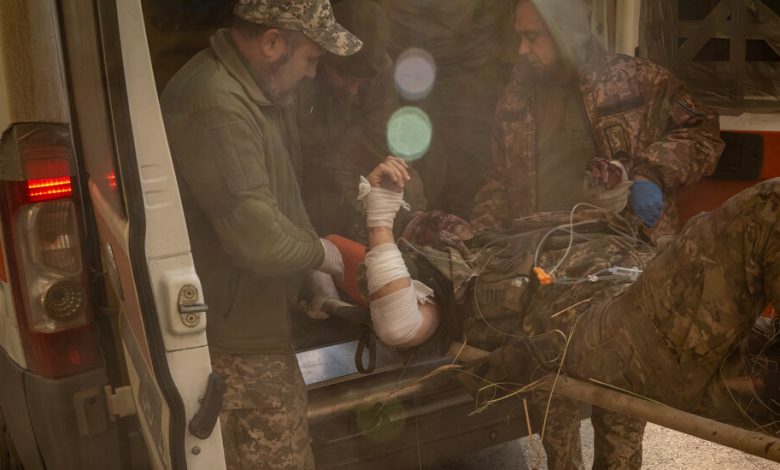Kill and Be Killed: Ukraine’s Bloody Battlefield Equation

As Russia mounted wave after wave of attacks over the summer, Sgt. Mykola Rogozovets and fellow members of his unit started drawing little plus signs in the dirt of their bunker while artillery shook the ground around them.
Each cross, said Sergeant Rogozovets, a 48-year-old unit commander in Ukraine’s First Presidential Brigade, represented a Russian soldier they had killed in fighting. He added 12 plus signs in a single day in August, he said, before a shell exploded at his position in northeast Ukraine and his left shoulder was wounded by shrapnel.
“When new guys replaced us, they asked, ‘What are these pluses?’” he said Friday in an interview at a base outside Kyiv. He told them what they stood for and then left with these words: “‘Continue our mission, kill the enemy and put pluses.’”
Ukraine, like all wars, is in large part about attrition: killing enough enemy soldiers and destroying enough of their equipment so that the opponent can no longer bear the cost of fighting.
Now, as the days grow shorter and autumn rains begin to soak the battlefields of Ukraine, that bloody equation is playing out under a relentless hail of artillery along the vast front line. Europe’s deadliest war in generations remains exceedingly violent, precariously balanced and increasingly complicated by factors far from the battlefield.
Ukrainian and Russian soldiers are squared off across trench lines that have barely shifted for nearly a year. Meanwhile, tens of millions of Ukrainians are bracing for another winter of terror and suffering as Moscow stockpiles missiles that could be used to target their nation’s infrastructure in an attempt to demoralize civilians and make cities uninhabitable.
Ukrainian forces are still fighting to break through heavily fortified Russian lines in the south, but the pace of their advance has been slow, averaging only 90 yards per day during the peak of the summer offensive, according to a new analysis by the Center for Strategic and International Studies.
That is the same pace as the Allied forces during the bloody five-month Battle of the Somme in 1916, the analysis said.
While Ukraine is still pressing its counteroffensive, defenders have the clear advantage in this war, said Seth Jones, one author of the report. Ukrainians pierced one line of Russian defense around the flattened village of Robotyne in the south. But after five months of brutal fighting, they have yet to achieve a major breakthrough.
Moscow, however, is not just sitting back on defense. It is using perhaps its greatest advantage — the sheer mass of its army — to launch renewed offensive operations in the east. In particular, its forces have staged their largest assault in months, with fierce, bloody fighting around the ruined Ukrainian city of Avdiivka.
The decision to commit thousands of soldiers and hundreds of tanks and armored vehicles to the fight for Avdiivka is a sign of the Kremlin’s confidence that it has sufficiently blunted the Ukrainian offensive in the south to allow it to press forward elsewhere.
“It is a kind of a dynamic balance right now: the Russian troops attacking along some stretches and the Ukrainians on others,” said Serhiy Zgurets, a military analyst and head of the Ukrainian national security think tank Defense Express.
‘The Ability to Last’
Two ongoing battles taking place hundreds of miles apart underscore the importance for both armies of being able to replenish their forces and equipment.
While Russia is attacking Avdiivka with ferocity, the campaign has been something of a disaster, some analysts say.
Its army has lost more than 100 tanks and armored vehicles and scores of fighters while failing to dislodge Ukrainian defenders, according to combat footage verified by independent military analysts.
Still, that determination to press shows Moscow’s ability to throw waves of soldiers into assaults, no matter the casualty count, and Anton Kotsukon, a spokesman for Ukraine’s 110th Separate Mechanized Brigade, said they expected the attacks to keep coming.
While the Russians are getting pummeled in armored assaults across mine-strewn fields in Avdiivka, he said, they are adapting and have started digging tunnels. “They can then unexpectedly emerge close to our positions,” he said.
They are also employing “robotic vehicles” to deliver ammunition to their troops, and despite their losses they have more in reserve.
“Every day they deploy additional forces to conduct assault operations — additional personnel, armored vehicles, aircraft, and artillery,” Mr. Kotsukon said.
More than 350 miles to the south, near the city of Kherson, Ukrainian forces have intensified their assaults on the Russian-controlled eastern bank of the Dnipro river, prompting speculation that Kyiv may be planning a more ambitious offensive effort there.
Russia has responded to the threat by hitting Ukrainian towns and villages along the river with some of the heaviest aerial bombardments of the war, said Natalia Humeniuk, a spokeswoman for the southern command.
Between 7 a.m. on Friday to 7 a.m. on Saturday, “a record number of 36 air bombs were documented,” she said. Dozens of civilians have been killed and wounded as 1,000-pound bombs fall from the sky.
“For a village, this represents a significant destructive force,” Ms. Humeniuk said.
Given the intensity of the fighting, military analysts generally agree that both sides will continue to struggle to generate forces capable of conducting offensive operations.
“It’s the ability to last that matters, the ability to replenish manpower and equipment,” said Thibault Fouillet, a researcher at the French Foundation for Strategic Research.
The War of Weaponry
Col. Ants Kiviselg, head of Estonia’s military intelligence service, said that Russia still had around four million artillery shells — enough to continue low-intensity warfare for another year. He also cited Western intelligence reports that suggested North Korea had recently transferred artillery shells to Russia, based on satellite evidence, and he estimated that as many as 350,000 shells had been delivered.
The shipments, he said at a news conference on Friday, show that the Kremlin “plans to continue its war in Ukraine for a long time and is taking concrete steps toward doing so.”
Jack Watling, a research fellow and specialist in land warfare at the Royal United Services Institute in Britain, or RUSI, wrote that it was likely that Russia would hold a “material advantage” in the coming months and that “Kyiv must fight carefully if it is to retain the initiative.”
One year ago, Russia was producing about 40 long-range missiles a month, analysts at RUSI reported. Now it is producing over 100 a month, the analysts wrote, an estimate that aligns with what the Ukrainian general staff said in September.
Ukraine, too, is stepping up its domestic weapons production, committing over $1 billion to drone manufacturing and inviting Western arms makers to partner in new weapons development.
But it is unclear how quickly it can ramp up production, and Ukraine remains deeply reliant on its allies for military and financial support.
President Biden is pushing a $61 billion aid package for Ukraine, a critical show of support but one dependent on a House Republican caucus increasingly skeptical of continued spending for Ukraine, especially in light of new outlays for Israel’s fight against Hamas.
“This war is an industrial war,” said Mr. Jones of the Center for Strategic and International Studies. “The key variable becomes, as you look at both sides, which side starts to weaken first in terms of aid provided by their respective partners.”
The Deep War
With frontal assaults proving difficult and deadly, the “deep war” being waged by both sides take on added significance. Ukraine hopes that targeting command centers, ammunition depots, supply lines and bases far from the front will steadily degrade Russia’s capacity to fight.
Mr. Biden’s decision to provide long-range missiles known as ATACMs, which arrived only in recent days and have a range of 100 miles, gives Kyiv the ability to target Russian positions across the entirety of territory it occupies aside from parts of Crimea.
The powerful missiles, which carry cluster munitions that spread more than 900 bomblets over a target area, were used to strike two key Russian forward operating bases last week, damaging or destroying at least 14 Russian attack helicopters that have played a critical role in the Russian defensive lines.
Every mile Ukraine can press forward in the south — where the front is only about 60 miles from the sea at any point — would create new problems for Russian forces.
Still, as analysts have pointed out, Russia has proved more facile this year in adapting to battlefield conditions, and it could try to alter supply routes, or use its own artillery and airborne weapons to counter Ukrainian shelling.
If Russian troops are drawn into the defense along a wide front, “then Russian forces will be outside, getting wet and cold,” Mr. Watling, the RUSI analyst, wrote. “If targeted strikes can degrade their logistics, then the limited training and field craft of Russian forces can maximize climactic injuries.”
In other words, even as Russia will seek to use winter as a weapon against Ukrainian civilians, Kyiv will try to disrupt Russian support systems well behind the lines and make winter a weapon against demoralized Russian soldiers.
Daria Mitiuk contributed reporting from Kyiv, Ukraine.



